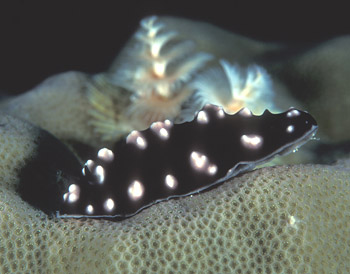Phyllidiella cooraburrama? from Papua New Guinea
November 30, 2002
From: Richard Harris

Hi there,
I came across a photo of Phyllidiella cooraburrama on Des Paroz's site and recalled one I also took in Kimbe Bay, Papua new Guinea this July. I think is the same species?? I may be guilty of placing the nudibranch on the hard coral pictured, I cannot recall. I note from your site that this species had not often been observed, so thought it may be of interest.
Any thought appreciated.
Thanks,
Richard Harris
harryh@bigpond.net.au
Harris, R., 2002 (Nov 30) Phyllidiella cooraburrama? from Papua New Guinea. [Message in] Sea Slug Forum. Australian Museum, Sydney. Available from http://www.seaslugforum.net/find/8496Dear Richard,
Thanks for this photo. It sent me back to Des Paroz's messages [message 1, message 2], where I suggested his animal might be Phyllidiella cooraburrama. I also note that Neville Coleman's 1001 Nudibranchs has this identified as Phyllidiella nigra. Identifying phyllidiids just from photos is a bit risky as often the essential characters are on the underside of the animal or in fact inside it. Also, we know so little about colour variation in most species, that deciding whether colour differences mean different species is not a very 'scientific' exercise.
Both P. nigra and P. cooraburrama are good guesses for this species but in Brunckhorst's monograph he specifically states that neither of these species has a 'pale edge to the mantle' and yet your photo clearly shows a continuous pinkish edge. There is a third species which fits this colour and tubercle pattern quite well and that is Phyllidiopsis burni. Brunckhorst specifically describes 'edge of mantle is very thin, smooth and translucent pink'. He also also states that the body is 'more acutely tapered than other phyllidiids'. Although this is difficult to quantify, your animal is quite pointed at each end.
I think your animal is Phyllidiopsis burni. And I suspect Des Paroz's is as well. You mention you may have placed the animal on the
Best wishes,
Bill Rudman
Related messages
-
Phyllidiopsis burni? from Thailand.
From: Richard Houghton, September 18, 2002 -
Phyllidiopsis burni from the Solomons
From: Rachel Murphy, July 8, 2002 -
Phyllidiopsis burni from Papua New Guinea
From: Mary Jane Adams, July 1, 2002 -
Phyllidiopsis burni from Christmas Island
From: W.B. Rudman, May 16, 2002 -
Phyllidiella pustulosa? from Lady Musgrave Island
From: David Harasti, February 19, 2001 -
Phyllidiopsis burni from the Marshall Islands
From: Scott Johnson, June 15, 2000 -
Re: Phyllidiella cooraburrama
From: Des Paroz, July 19, 1999 -
Re: Phyllidiella cooraburrama
From: Des Paroz, July 14, 1999 -
Phyllidiella cooraburrama from Papua New Guinea
From: Des Paroz, July 13, 1999
